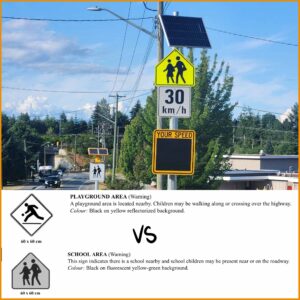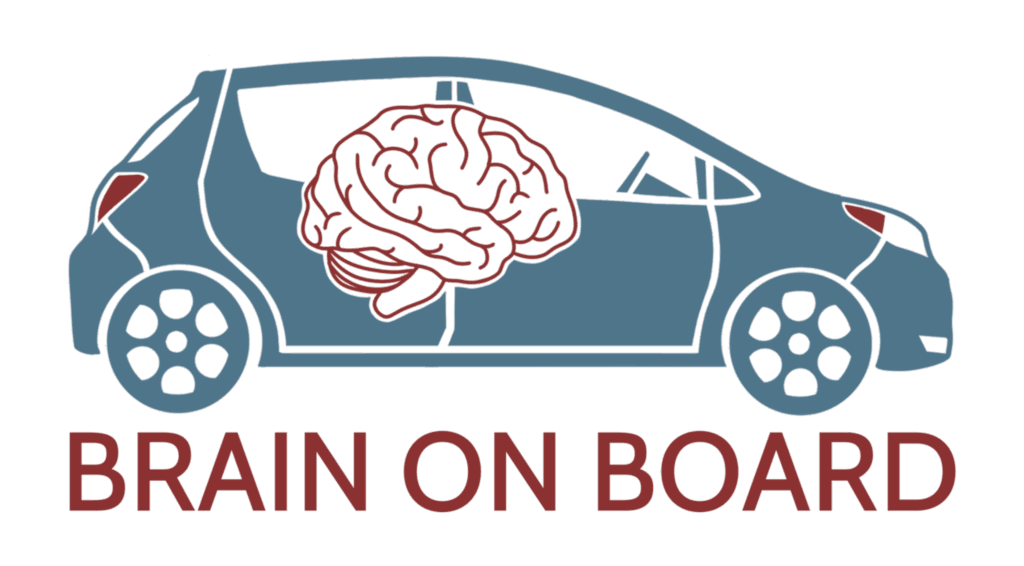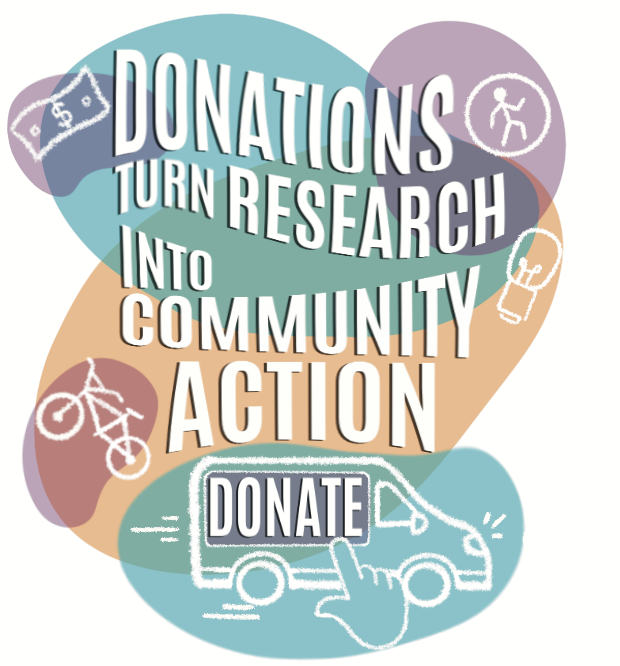A TIRF Youth Advisor Program (TIRF YAP) blog.
TLDR: We’ve all cruised past a school on a Saturday morning in July and wondered if we should hit the brakes… just in case. Here’s the thing: school zones are only active from 8 AM to 5 PM Monday to Friday (actual school days) in most Canadian provinces, whereas playground zones run from dawn to dusk, every day of the week. Yes, they’re different! And while you may believe slowing down to 30km/h is the right thing to do just to be safe, you may unintentionally increase risk to other road users, including pedestrians and cyclists. Road rules create predictability so we can anticipate the actions of others sharing the road with us, which prevents avoidable collisions. Let me explain why.

Before we delve into this topic, it’s important to bear in mind that the overriding goal is keeping kids safe every day. CHEK News recently highlighted ICBC data showing September is the riskiest month for children travelling to and from school in B.C., with an average of 50 injuries reported.
Additionally, a recent BCAA survey revealed “91% of respondents reported seeing speeding over the limit in school zones, while a troubling 84% said they witnessed distracted driving.” More concerning is that 8 in 10 respondents had witnessed drivers travelling through school zones who didn’t stop for students at marked crosswalks or pedestrian bump-outs.
And, in Ontario, concern for school zone safety prompted a partnership between Peterborough County, Ontario Provincial Police (OPP) and Peterborough Police Service (PPS) to increase enforcement within school zones and remind drivers to slow down in school zones, stop for school buses and give at least a metre clearance for cyclists.
Wait, school & playground zones are different?
Whether you first learned about them in driver’s ed or picked it up through a parent or peer, the rules for school zones and playground zones can be easy to mix up, especially since either specific rules or conditions vary widely across Canada. Understanding the difference is important to be compliant and safe, and the best place to start is with the official driver handbook in your province.
Playground zones are there to protect kids where they play, whether it’s during the school year, on weekends, or in the middle of summer. Swings, slides, and soccer games don’t really follow a calendar. That’s why in many places, like British Columbia, these zones have a 30 km/h speed limit from dawn until dusk, seven days a week, year-round (BC Traffic Signs & Pavement Marking). The exact rules can vary a bit depending on which province you’re in, so if you’re road-tripping across Canada, it’s worth checking local regulations. But this is the general framework most places follow.

School zones, on the other hand, tend to be active for shorter periods linked to the school calendar, but the timing can look very different from one jurisdiction to another:
- In British Columbia, most school zones are 30 km/h from 8:00 a.m. to 5:00 p.m. on school days (ICBC Learn to Drive Smart).
- In the City of Winnipeg, school zones are in effect from 7:00 a.m. to 5:30 p.m., September through June, Monday to Friday, including holidays that fall on a Monday or Friday.
- In the City of Calgary, the city has combined school and playground zones into one category called playground zones, which are enforced from 7:30 a.m. to 9:00 p.m., seven days a week, year-round.
If it’s been a while since you reviewed these rules, or you live in an area without schools or playgrounds, you might not have noticed how signage differs:
- School zone signs are often in the shape of a yellow schoolhouse icon with two young people walking and may even specify hours or days.
- Playground zone signs may show a playground symbol with a speed limit and can apply for longer hours or year-round.
Without a national standard, it’s worth checking current rules in the province or city where you’re driving. Handbooks are available online, such as BC’s Learn to Drive Smart, Ontario’s Official MTO Driver’s Handbook, and Newfoundland & Labrador’s Road Users Guide.
When being extra safe backfires
Now I’m going to say something which might sound counterintuitive: sometimes trying to be super cautious can actually increase risk.
Picture this: It’s a gorgeous Sunday morning. You’re driving past a school that’s clearly closed, no cars in the parking lot, no kids in sight, or some are playing within the fenced yard. But you think, better safe than sorry, and suddenly slow down to 30 km/h anyway.
Your heart’s in the right place, truly. But here’s what you might not realize is happening behind you: the driver following you just slammed on their brakes. They weren’t expecting you to suddenly slow down. Then, the person behind them swerves into the other lane avoid a collision or to pass and then cut off yet another driver. Suddenly, there is a chain reaction of confused, frustrated drivers, all because a driver abruptly reduced their speed with no warning. In other words, when drivers act in ways that are unpredictable and inconsistent with the rules of the road, it can lead to preventable collisions.
Road safety isn’t just about making the safe choice, it’s about being predictable. When we all follow the same rules and drive in ways other people can anticipate, traffic flows smoothly and safely. But when someone throws a curveball by unexpectedly reducing their speed for no observable reason it messes with that flow.
I’ve seen it myself:
- rear-end collisions because someone didn’t expect the car in front to brake suddenly or substantially reduce their speed without warning
- dangerous passing maneuvers because drivers are trying to avoid a rear-end collision or get impatient (note that frustration is no excuse for making risky choices even if it feels justified at the time)
- pedestrians and cyclists can’t anticipate how fast traffic is actually moving, which can lead to some scary close calls
But don’t throw common sense out the window
Now, before you think I’m telling you to ignore your instincts completely, let me be clear: I’m not saying you should blindly stick to the speed limit no matter what’s happening around you. Remember, speed limits are maximum thresholds for ideal road and weather conditions, and contrary to popular belief, they are not a target.
If it’s the middle of July or a weekend and you’re driving past a school where kids are clearly playing right beside the road, absolutely slow down! Just because it’s not technically a school day doesn’t mean you shouldn’t use your brain, which is your most important safety feature. Maybe there’s a summer camp happening, or some kids are having an impromptu soccer game on the field. Let’s face it, everyone knows a rogue soccer ball rolling across the road is almost always followed by a child chasing it down.
The truth is, traffic laws give us a solid foundation to navigate the roads, but they can’t account for every possible real-world scenario. The key is to use your judgment. If you see kids near the road, slow down, sign or no sign. If the area is completely deserted and it’s clearly not an active school day, following the posted speed limit is actually the safest, most predictable choice.
The bottom line
Look, we can all agree that the safety of children on the road is a top priority. School zones and playground zones exist for exactly that reason, and they’re set up to protect children when they’re most likely to be out near the roads.
But here’s what I’ve learned: the best way to keep everyone safe isn’t always to drive as slowly as possible. It’s to be predictable, follow the posted rules, stay alert, and use common sense.
School zones during school hours? Absolutely slow down to the posted limit. Playground zones during their active times? You bet. Empty schools on a weekend or late evening with no kids in sight? Stick to the regular speed limit and keep traffic flowing smoothly so the driver behind you doesn’t get an unexpected surprise that ends in a collision.
Predictability keeps us safe, along with a healthy dose of common sense and paying attention to what’s happening around us.

Source documents & resources:
BC Ministry of Transportation and Infrastructure. (n.d.). Traffic signs & pavement marking. https://www2.gov.bc.ca/gov/content/transportation/transportation-infrastructure/engineering-standards-guidelines/traffic-engineering-safety/traffic-signs-markings
Brougham, L. (2025, August 26). 31% of drivers admit to speeding in school zones ‘sometimes’: ICBC. CHEK News. https://cheknews.ca/31-of-drivers-admit-to-speeding-in-school-zones-sometimes-icbc-1274750/
City of Winnipeg. (2023, August 22). Reduced speed limit in school zones. https://www.winnipeg.ca/police/community/news-releases/2023-08-22-reduced-speed-limit-school-zones
City of Calgary. (n.d.). Playground zones. https://www.calgary.ca/roads/safety/playground-zones.html
Desjardins. (2023, November 10). Helping your teen learn to drive. Desjardins, Advice. https://www.desjardins.com/bc/en/tips/learn-to-drive.html
Government of Newfoundland and Labrador. (n.d.). Road users guide. https://www.gov.nl.ca/motorregistration/new-drivers
Insurance Corporation of British Columbia (ICBC). (n.d.). Learn to drive smart. https://www.icbc.com/driver-licensing/driving-guides/Learn-to-Drive-Smart
Ontario Ministry of Transportation. (n.d.). Official MTO driver’s handbook. https://www.ontario.ca/document/official-mto-drivers-handbook
Peterborough County. (2025, August 25) Increase Traffic Enforcement as Students Return to School, With New Policies Developed to Enhance Safety Across School Zones in Peterborough County. Peterborough County. https://www.ptbocounty.ca/news/posts/school-zone-safety-as-a-priority-opp-and-peterborough-police-service-to-increase-traffic-enforcement-as-students-return-to-school-with-new-policies-developed-to-enhance-safety-across-school-zones-in-peterborough-county/
Royal Canadian Mounted Police. (2024, August 21). Speed limits. RCMP. https://rcmp.ca/en/bc/road-safety/legislation/speed-limits
Traffic Injury Research Foundation. (n.d.-a). Raise your hand if you’re a safe driver [Blog post]. https://tirf.ca/blog/raise-your-hand-if-youre-a-safe-driver/
Traffic Injury Research Foundation. (n.d.-b). Brain on Board. https://brainonboard.ca/
Related topics:
 |
 |
 |







